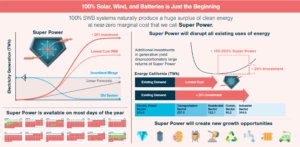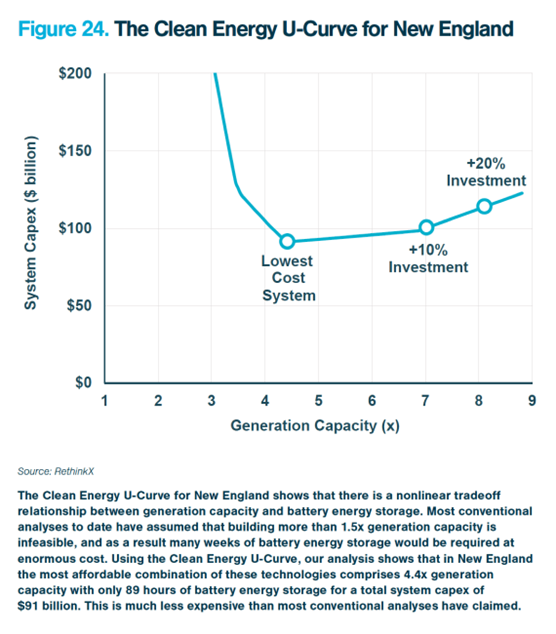Solar photovoltaics, onshore wind power and lithium-ion batteries (SWB) will displace fossil fuels and conventional nuclear power during the 2020s. This will create an entirely new business model – SWB Superpower – that will disrupt and transform our energy sectors exponentially.
Should major changes in a number of key technologies come together, we will witness a disruption with possible major consequences for our society, according to RethinkX. Such a disruption comes near in five important sectors of our economies: information, food, transport, energy and materials. According to Tony Seba and James Arbib, founders of RethinkX.
Major changes
The most important sector where major changes are taking place is the energy sector. Since 2010, costs for solar PV have fallen by over 80%, those for onshore wind power by more than 45%, and those for lithium-ion batteries by almost 90%. Together, these solar, wind and batteries (SWB) price reductions will bring about a stepwise change in our energy production systems. It can even be predicted that these price reductions will continue in our decade.
Coal, oil and gas industries will be unable to compete by 2030, and will be entirely disrupted by SWB. Incumbent coal, gas and nuclear power plants are already unable to compete with new solar and wind installations. By 2030, battery-firmed SWB capacity will take the lead. The disruption of conventional energy technologies is now inevitable.
The cheapest energy option
However, conventional analysts have failed to predict the rise of SWB. This is because they falsely assumed that solar PV and wind power cannot supply 100% of electricity without weeks’ worth of battery energy storage. But they didn’t take into account a new factor: that with the low future prices, we might construct a major overcapacity of solar and wind power. So that we will need less battery capacity.
Regional analyses done by RethinkX confirm that solar, wind and battery are 100% achievable, and our cheapest energy option. This can be achieved anywhere in the world. Of course, different setups will be needed in different parts of the world (check the curve). According to RethinkX, cost optimized SWB systems are by far the cheapest option compared to existing conventional power plants.
Spare capacity
RethinkX’s regional analysis shows that:
- A 100% SWB system is both physically possible and economically affordable by 2030
- The amount of battery energy storage required to support a 100% SWB system is much lower than is widely believed
- A 100% SWB system will be the cheapest option for electricity generation in most populated areas by 2030.
In all these systems, total generating capacity far exceeds demand. For instance, in the case of New England (the most problematic region, in RethinkX’s analysis of US regions), the most affordable combination will contain much more generating capacity than formerly thought. The optimal (least-cost) combination will contain up to twice maximum demand; on the other hand, required battery storage capacity will reduced, to a typical 89 hours.
 SWB superpower
SWB superpower
The total investment required, just in New England, amounts to $ 91 billion. This would seem to be a lot, but it is much less than most conventional analyses have claimed. And then, the vast majority of people live in areas with much more sunshine than New England. Moreover, major extras will arise from just 10 or 20% extra investment. This leads to what RethinkX calls ‘SWB superpower’ (of sun, wind and batteries) – a situation with exceedingly high energy production (to be used for all kinds of purposes, the majority of time) at very low extra cost.
SWB superpower will have major advantages. Nations that invest in superpower are in control of their own energy destiny. They will not be not reliant on other countries, or susceptible to market constraints or shocks. On top of that, superabundant energy will create a thriving economy; the cost of energy will barely be a factor and superabundant supply is a given. Therefore, nations that adopt SWB superpower will become highly resilient to external shocks or other potential disruptions. As a matter of course, superpower is of a distributed nature, and will therefore enable a rapid and simple recovery.
Close poverty and equity gaps
According to RethinkX, SWB superpower will transform our societies. The superabundance of clean energy will open the door to extraordinary new possibilities for society, the economy and the environment. Just as the internet gave us information and communication at near-zero cost, the superabundance of clean energy will open the door to extraordinary transformations. Like ‘water desalination, road transportation, residential and commercial heating, waste management and industrial and chemical processes.’
SWB superpower can be implemented anywhere. This will lead to localization, decentralization and democratization of energy production. It is stable and resilient, and will allow less developed countries to close poverty and equity gaps. This new energy system will help us leapfrog over previous barriers to human development, an entirely new situation for society.

The final blow to nuclear power
SWB superpower will also mean the final blow to nuclear power. The most important shortcoming of nuclear power is that it is extremely expensive, compared to all other energy options. All aspects of its operation require extensive safety measures, that cannot be borne by everyday operations. According to RethinkX, the cost of nuclear electricity ranges from three to over thirty times over SWB electricity. Moreover, the cost of nuclear power has risen over 25% in the last 10 years; while in the same period SWB costs have fallen a lot. And nuclear power gets more expensive all the time. It is one of the few industries in history with a negative experience curve: it gets more rather than less expensive as we build more of it.
Apart from that, there are aspects of nuclear power that may still add to its costs, like decommissioning. They use too much water for cooling – many countries aren’t rich in water. Nor do most countries have the wealth, human resources and political stability required to safely use nuclear power. And then we don’t even talk of possible proliferation of weapons material, long build times, reserves of uranium and rare materials required for the operation of these power plants, the possibility of accidents, nuclear waste management, siting constraints and the absence of technological developments that might help us overcome these problems. In short: nuclear power will never be able to compete with SWB superpower.
Energy will be almost free
The fact that SWB superpower will come with an excess of almost free energy, will have profound consequences. This will create unprecedented opportunities for every region that chooses to adopt a 100% SWB system. RethinkX foresees that this will lower the cost of energy across an entire region and trigger a virtuous cycle: more individuals that move in — attracted by the higher quality of life; more companies that move in — attracted by talent and low energy costs; and more investments that move in — attracted by growth opportunities. Oil and gas companies will disappear. Precisely the overcapacity triggered by SWB superpower will lead to intelligent utilization of the excess.
SWB superpower will be stimulated by land falling free because of the disruption of the food cycle happening at the same time; land that can be repurposed for SWB activities. The excess energy generated by SWB overcapacity will stimulate the disruption of the transport system. The excess battery storage capacity created in this way will in turn stimulate ‘the economic, social and environmental benefits of the SWB disruption itself.’
Solving old problems
And RethinkX supposes it may stimulate developments now hindered by a lack of affordable energy. Like urban redevelopment. Agricultural innovation in the form of energy-efficient greenhouses and vertical farming. Reduction of energy poverty, improvement of living standards and fostering of community engagement. As RethinkX writes with characteristic optimism, we will be able to solve many old problems. We will be able to move from ‘a world of inequity and predatory competition to one of shared prosperity and collaboration.’
This may all be true. But what about new power structures that will form in the course of this revolution? Will there be winners and losers in the process? Will new inequalities be created? We’ll have to wait and see!
Interesting? Then also read:
The future of renewable energy
Local network required against grid congestion
RethinkX, an evaluation

